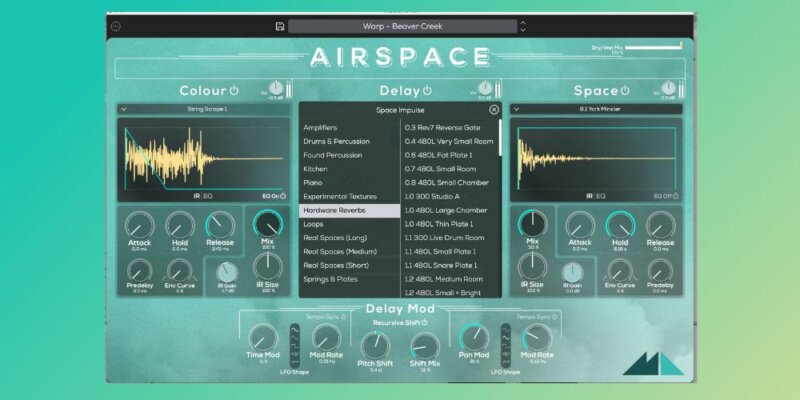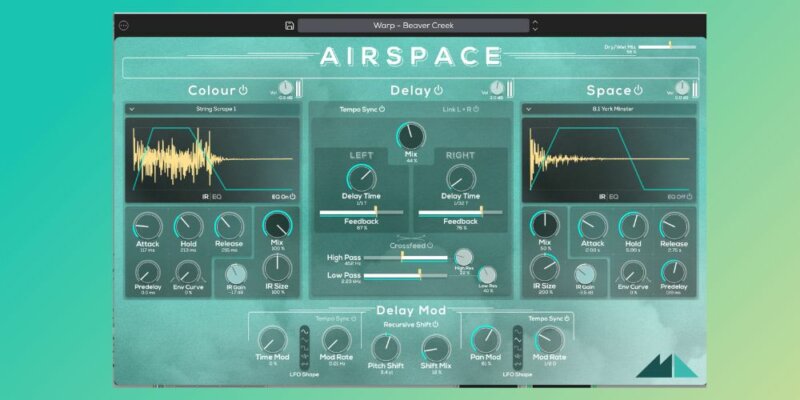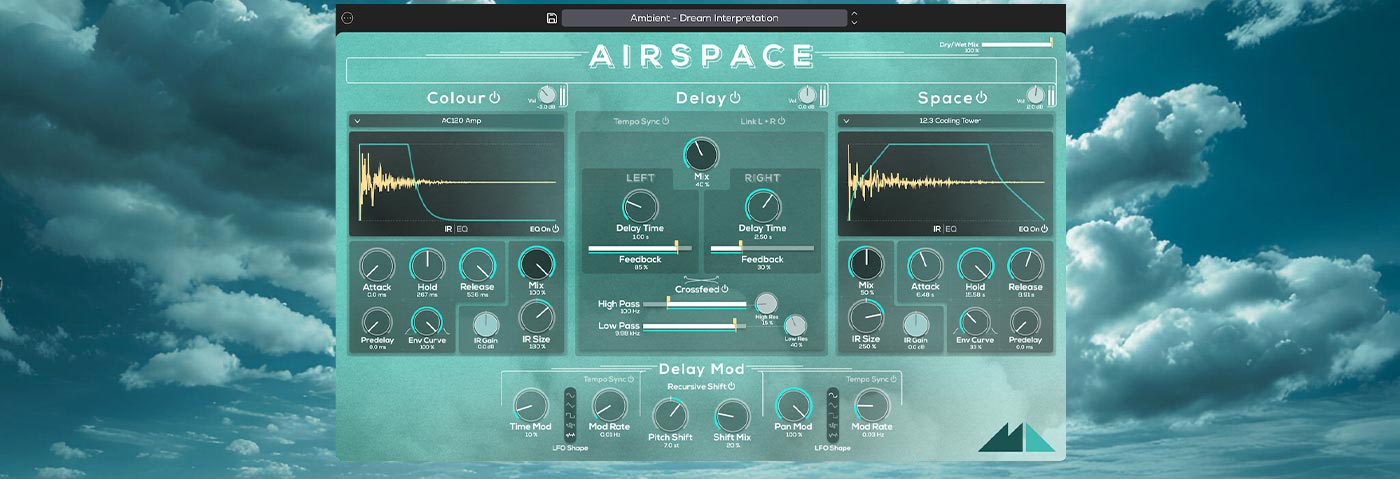When is a reverb more than a reverb? We patrol ModeAudio’s brand new Airspace to find out more…
Reverbs are often taken for granted. And it’s understandable too… all modern DAWs have decent built-in ‘verb, and it’s not exactly the sexiest effect. Every now and then you might splash on something high end, promising ‘the sound used on <whatever>’, but when was the last time you invested in a creative reverb plugin?
Sample and preset pack purveyor, ModeAudio, hopes the answer to that question will soon be ‘Funny you should ask – I just bought a great one called Airspace’. And, at the risk of spoiling the surprise, their first audio effect plugin makes a good case.
To be clear, it’s an undersell to label Airspace a reverb. But much like how cucumber makes everything else in a sandwich taste like cucumber, when you stick reverb in an effects plugin, it sounds like a reverb plugin.
Convolution and impulses and delays… oh my!
Airspace is actually made up of three sections: a sound-colourer, a delay, and a reverb. Making things interesting, the colour and reverb sections are convolution-based. If you’re relatively new to production it’s likely you’ve never encountered convolution processors, so it’s worth an extended-disco-mix-length recap.
Convolution’s promise is to perfectly recreate the sonic characteristics of real spaces or audio devices. It works by playing and recording test signals in a specific environment, or through a signal path, generating an ‘impulse response’ (IR). Software then uses that IR to apply those characteristics to anything you like. Convolution kicked off in 1999 with Sony’s DRE-777 and, by the mid 00s, was the next big thing. Until it wasn’t.
Not only did convolution offer more realistic spaces than dreamt possible, it allowed you to get in-the-box emulations of classic compressors and EQs that the algorithms of the day simply couldn’t match. Audio Ease’s Altiverb, Waves IR, and Logic’s Space Designer are still probably the most well-known IR plugins, and all came out around that time.
Why did the buzz die? Convolution chugs CPU cycles like a groom slams shots on a stag weekend, and by the time the CPUs were powerful enough to make light work of IR plugins, virtual analogue algorithms were recreating classic hardware perfectly. Which ties in to the second reason – convolution excels at real spaces but, in most popular genres, emulations of classic digital and mechanical reverbs rule. Still, though, if you need a fart recorded in your bedroom to sound like it was expelled in the Sistine Chapel, nothing gets you closer than convolution.

The real genius here is how perfectly designed and calibrated it all is
Everything comes back into fashion
And this, history lesson over, brings us back to Airspace. Modern CPUs mean IR now has all the same advantages and few of the downsides. And if IR does one thing really well, it’s to let you mess around in cool and impossible-to-emulate kinds of ways. After all, you can make an IR out of anything you like. And that’s the idea of Airpsace’s Colour and Space sections.
Eagle-eyed readers will spot that the controls for Colour are identical to the ones for Space, and that’s not just skin deep – they’re identical behind the scenes. The difference is the kinds of IRs you might use in each. Colour-focused IRs include cool and creative stuff like guitar amps, scraped knives, glass bowls, pocket change, and even velcro. Space IRs are longer, taking in mammoth houses of worship, iconic digital reverbs, and, in case the need arises, the Women’s Club in Spokane, Washington.
Sensibly, ModeAudio doesn’t restrict either module to specific IR types. So you can make a vocal sound like a wooden tray, and then make a vocal that sounds like a wooden tray sound like the zip on your jeans. Or you could create a snare track that sounds like it was recorded in York Minster Cathedral before being run through a Lexicon 480 church preset. Meta stuff, eh?

Pushing the envelopes
Now back to those controls. First up are envelope knobs, shaping how the IR is applied. Then pre-delay, for offsetting the start point of the processed signal. Mix adjusts the dry / wet balance. IR Gain is for taming the massive level differences IRs can introduce. Finally, an IR Size knob lets you shorten or stretch the IR from 20% of its original length up to a whopping 500%. Used creatively or otherwise, it all sounds great and usable.
Sitting between those two IR modules there’s a stereo delay that largely does what it says on the tin, throwing in a nice left-right feedback option to spice things up. Airspace then dials things up to 11 with an awesome delay modulation section featuring a powerful-but-easy-to-use pitch shifter. This lets you do things like change the pitch of the signal before feeding it back into the delay signal path. Put simply, the range of results, and the ease with which you can get them, is off the scale.
What’s the verdict, then? The great things about convolution are that it offers a staggering range of sound with minimal controls and can sound bloody wicked – both of which sum up Airspace pretty well. This plugin also makes a tasty live set proposition, aided by a scalable / resizable GUI (also handy in the studio for high-resolution displays and low-resolution eyesight).
What’s not to love? It’s a minor gripe, but if you don’t want to explode your speakers and eardrums, presets should be browsed with the monitoring volume low – many don’t take full advantage of that aforementioned IR gain response knob.
Additionally, I’d like to mess with the signal routing a little, placing the delay first or last, and maybe even sending feedback from different plugin sections back to the input.
Finally, it would be fun to have a companion application for capturing your own impulse responses. It’s an amusingly hit-or-miss undertaking, but rewarding when you nail it. I still use a 15-year-old image of the concrete staircase from my old recording studio complex in London. It was in an old gasworks, now demolished to make way for luxury flats, and the sound yields nostalgic goosebumps whenever I add it to percussion.
Three-in-one and one of a kind
In the end, Airspace is far more than the sum of its already-pretty-cool parts. Each section is a nice effect on its own (and can be used that way too), but taken together they’re awesome.
Is this going to be your only reverb? Probably not. There’s always room in a mix for something like Relab’s outstanding LX480. Will it be the last saturator plugin you ever use? Unlikely – Izotop’s Trash 2 offers advanced convolution-based fun too. And, finally, will you become a monogamous, one-delay producer who avoids eye contact with every Lexicon you see, in case it gets the wrong impression and leads you into temptation? If that’s your goal, just don’t have that second glass of rosé in the company of PSP Audioware’s PSP 285.
But that’s really not the point. The real genius here is how perfectly designed and calibrated it all is, the inventiveness, and the quality of the 450+ IRs. Even somebody with no experience of mixing or convolution can instantly create crazy new textures, and a healthy 245+ presets let you put Airspace instantly to use for both conventional or creative mixing purposes.
Lastly, it must be said, placing a delay between those two envelope-equipped convolution engines is inspired. Everybody making techno, doing sound design, or who is simply excited about the idea of creating an entire groove, complete with bassline / melody, from nothing more than a 4-4 kick drum signal, needs to take the 14 day trial for a spin.
The Verdict
Price: £60
Purchase: ModeAudio Airspace
The Final Word
The real genius here is how perfectly designed and calibrated it all is, the inventiveness, and the quality of the 450+ IRs.
